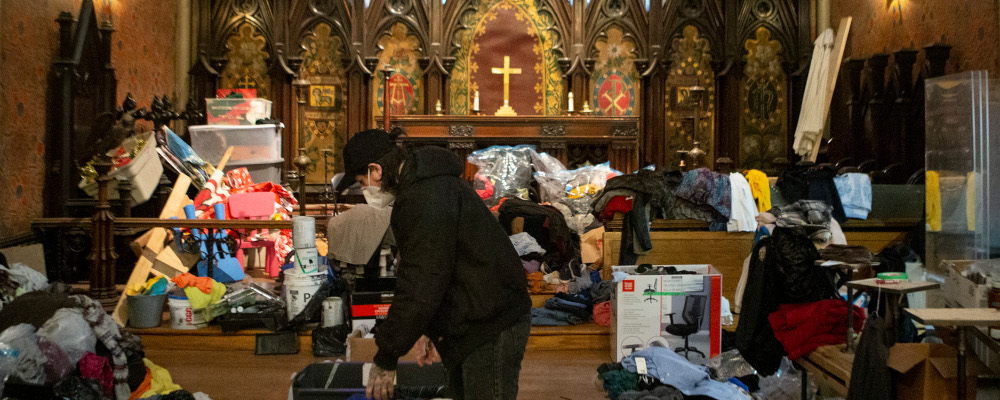The little Anglican church in my neighbourhood is sponsoring a Ukrainian family to settle in Canada. Under the Government of Canada’s Private Sponsorship of Refugees program, the congregation has committed to covering all of the family’s expenses, and providing social and emotional support, for the first 12 months of their new life in Canada.
Refugee sponsorship is just one of myriad ways that faith congregations—Christian, Muslim, Jewish, and others—contribute to Canadian society. (For a fascinating history of religious Canadians’ involvement in refugee resettlement, see Geoffrey Cameron’s Send Them Here: Religion, Politics, and Refugee Resettlement in North America, recently published by McGill-Queen’s University Press).Send Them Here: Religion, Politics, and Refugee Resettlement in North America https://www.mqup.ca/send-them-here-products-9780228005513.php Researchers have long studied the social, psychological, and civic benefits that accrue from religious belief and religiously motivated behaviour. But, how much does the existence and activity of religious congregations contribute annually to the Canadian economy? The Halo Project at Cardus is an effort to answer that question in dollars-and-cents terms.
Our latest research suggests that the activity of Canada’s more than 20,000 religious congregations produces $18.2 billion worth of benefits for society. We use a method first developed by researchers at the School of Social Policy and Practice at the University of Pennsylvania, which we adjusted for the Canadian context. A congregation’s economic impact can be assessed on the basis of 41 variables, in the following categories:
- Open space, used for recreation or providing environmental benefit
- Direct spending on salaries, operations, and facilities
- Education through an on-site school or child care, among other programs
- The “magnet effect” of attracting attendees to bar/bat mitzvahs, funerals, concerts, weddings and the like, who then spend their dollars at hotels, restaurants, and other businesses
- Activities that benefit individual people, such as counselling, refugee resettlement, and other forms of assistance
- Community development, including housing initiatives and job-training programs
- Social capital and care, such as food banks and AA meeting space
The details of our methodology can be found in our 2016 report, which was a pilot study of ten Toronto-area congregations.Valuing Toronto’s Faith Congregations https://www.cardus.ca/research/communities/reports/valuing-torontos-faith-congregations/ Since then, researcher Mike Wood Daly has applied the methodology to 76 congregations across Canada and to 100 congregations in not-yet-published research.Dollars and $ense: Uncovering the Socio-Economic Benefit of Religious Congregations in Canada https://journals.sagepub.com/doi/10.1177/0008429820921498
The latest work suggests that direct spending accounts for 26 percent of a congregation’s total Halo impact, on average. This finding has enabled us to create a Halo Calculator powered by congregational-spending data that we obtained from the T3010 Registered Charity Information Return that congregations file with the Canada Revenue Agency. Users of the calculator can enter the name of a congregation, or a city or other geographic area, and receive its corresponding Halo estimate.
There are some important limitations of our methodology. First, some of the variables require self-reporting by the congregation that we are not able to independently verify. Second, our research does not seek to account for negative economic impact that congregations may generate. To take one important example, some people have been abused in congregational settings. Costs relating to their recovery or to the prosecution of the offender are not included in Halo studies. And finally, I want to emphasize that the calculator provides only an estimated Halo value for congregations that have not been directly studied. To obtain the actual Halo impact, a congregation would need to apply its own data to each of the 41 variables.
Yet the Halo Project provides a valuable lens through which to view the contribution of faith communities to our shared life. In my city of Hamilton, ON, for example, the calculator reveals that there are 236 congregations producing an estimated $347 million in economic activity. If Hamilton is similar to other places where Halo studies have been conducted, almost nine of 10 people benefiting from these congregations’ programs and services are not members of those congregations.The Economic Halo Effect of Historic Sacred Places https://sacredplaces.org/uploads/files/16879092466251061-economic-halo-effect-of-historic-sacred-places.pdf
Some faith groups in Canada have an outsized Halo impact. Jewish congregations account for just one percent of the congregations in the data set yet produce three percent of the total Halo impact. Mennonite Christians have three percent of the congregations but command four percent of the impact. Congregations in BC, Alberta, Manitoba, and Ontario have a disproportionately higher Halo impact than do those in other provinces.
Congregations across Canada are at work each day contributing to a stronger and more resilient social fabric, and the impact of religiously motivated activity is enormous. The Halo Project is focused on congregations only, but other religiously motivated non-profits are active as well. Cardus has profiled the work of some of these: Ve’ahavta provides food and services to the very poor. The Service d’accompagnement spirituel pour les personnes malades ou âgées à domicile (SASMAD) is helping to make the lives of the sick and elderly a bit less lonely. Ismaili CIVIC mobilizes volunteers to contribute to all sorts of worthy causes.
Of course, non-religious Canadians and groups are also active in giving and volunteering. But the fact is that religious Canadians contribute disproportionately more, to both religious and non-religious causes. Forty-five percent of the country’s total giving comes from the 14 percent of Canadians who attend religious services on a weekly basis, as do 29 percent of total volunteer hours. Returning to the example of refugee resettlement, my quick scan of the names of the 130 sponsorship agreement holders suggests that 94 of them are religious organizations.
As the percentage of Canadians who participate in religiously motivated activity declines, these contributions will decline also. The socio-economic effect will be felt by us all. Will other civil-society institutions, or the various levels of government, be able to increase their contributions to fill the gap? The Halo Project demonstrates how enormous a challenge this will be, in dollar terms. If the trend continues, all Canadians—religious or not—will be poorer for it.
Recommended for You

How Canada built, then broke, the world’s best immigration system

The unceded advantage: Alberta and Saskatchewan’s case for tit-for-tat federalism

Canadian governments spent $158 billion on green economy but created only 68,000 jobs: report

Energy is everything for Canada and the world



